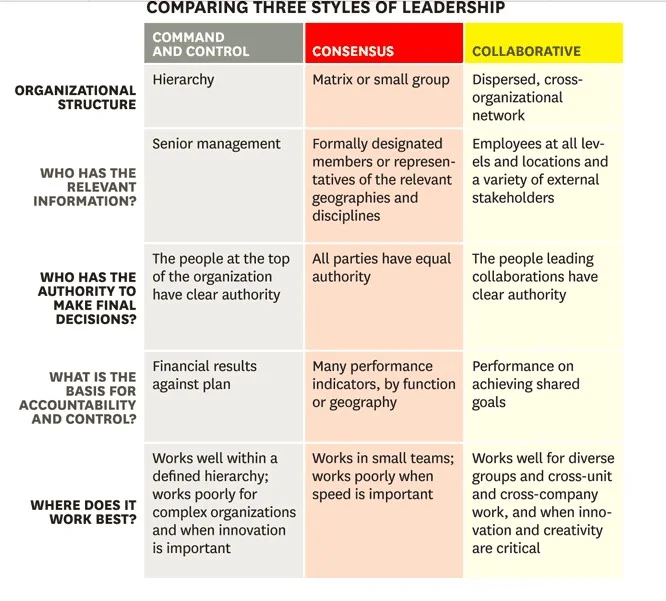
Being collaborative is something many of us struggle with, yet it is required to be a successful leader, do meaningful work and have a fulfilling life. So why is it so hard?
Many of us don’t agree on a definition or have a framework for what it looks and feels like. We have to have a shared mindset and common language as a place to start.
COLLABORATION DEFINED
When we look it up in the dictionary, collaboration is defined as: to work jointly with others or together especially in an intellectual endeavor. To cooperate…
Well, what does that actually mean?
When we work, we have certain steps we follow from idea to implementation or issue to execution. When we work alone, it can appear as if we jump from idea/issue straight to implementation/execution because much of the work and “discussion” happens internally. When we work with others, we have to draw that work and those steps out. Here is a simple framework that helped me think through the steps and how I might invite others in to the process to collaborate:
Idea/Issue → Invitation → Discussion → Decision → Implementation/Execution
THE INVITATION
Working with others and collaborating requires us to invite others into the idea we have or issue we see. This is a huge and often overlooked part of collaboration. People don’t know what we know, they don’t see things the way we see them. We have to make time to present the idea or the issue in a way that people can work to understand, see, feel and know.
THE DISCUSSION
Another area we often witness people fail is not giving enough time for discussion. We need to make space for exploration of options, implications, other ideas, etc. before we move to a decision. This slows down the process and can create conflict which is why we avoid it. It’s important to put parameters around this step so we don’t get stuck in discussion, and so that people have ground rules for how we speak with each other when there are disagreements or alternative viewpoints presented.
SUCCESSFULLY MOVING PAST THE DECISION
Once we make a decision, another fail point can be not making enough time and space to discuss how we will implement or execute. Who is doing what and by when? How will we track progress? How will we consider how things are going and regroup if necessary? At a micro-level, outlining, explaining and following this process can help us become a more collaborative leader.
COLLABORATION AS A MODEL
At a macro-level, let’s consider what collaborative environments look and feel like using this chart from the Harvard Business Review article published in 2011 entitled Are You a Collaborative Leader? by Herminia Ibarra and Morten T. Hansen.

EXPECTATIONS MUST MATCH EXPERIENCE
A few things to consider. First, all three of these models can work when we set expectations appropriately whether it’s on a project or an ongoing environment. The key is that the expectations you are setting match the experience people are having. When we say we are collaborative but people experience command and control then frustration, confusion and disengagement will most certainly be present.
CONSIDERATIONS FOR EACH MODEL
It’s also important to consider that in a command and control environment, the people at the top need to take radical responsibility and accountability for all outcomes. There are many environments we walk into where the people at the top want to dictate the decisions but then pass blame to the frontline employees. This creates an unhealthy and unsustainable work environment.
In a consensus model, it’s important to have clear and specific parameters around how we will move into a decision and gain commitment. This is a model where we can get stuck in discussion and not move into decision, so set your expectations clearly for timelines, how you will gain commitment, what signals we are ready for a decision, etc.
In collaboration, it’s important to consider what information is necessary for people in the process so we are not sharing information that shouldn’t be shared or would put unnecessary stress on people by sharing too much too soon. We have to have emotionally mature, healthy and whole leaders participating in order for collaboration to work well. In addition, we need to invest a lot of time and energy into considering timelines and roles for each step of the process: how will we move through from idea to implementation, who will be included in each step, etc.
INVESTING UPFRONT ALWAYS PAYS OFF
Command and control can be easier because there is less prep work involved on the front end. You may be able to move further faster, but you will face more resistance, misunderstanding or confusion, and possible frustration which you will have to clean up on the back end. When we invest necessary time and energy to be more collaborative, implementation and execution become easier and more enjoyable. People are more committed, and successful change is sustainable long-term.
In closing, consider this excerpt from the HBR article we previously referenced:
Leaders today must be able to harness ideas, people, and resources from across boundaries of all kinds. That requires reinventing their talent strategies and building strong connections both inside and outside their organizations. To get all the disparate players to work together effectively, they also need to know when to wield influence rather than authority to move things forward, and when to halt unproductive discussions, squash politicking, and make final calls.
Differences in convictions, cultural values, and operating norms inevitably add complexity to collaborative efforts. But they also make them richer, more innovative, and more valuable. Getting that value is the heart of collaborative leadership.

Written by: Lindsay Leahy, Dream Builder with The Restoration Project


